When a PDF contains images, the DPI of those images is necessary for print quality. Users need to know about the DPI to guarantee top-notch print quality and preserve visual reliability on electronic devices. Additionally, users face issues such as bad print quality, big file sizes, and slow downloads.
It's essential to strike the right balance of DPI in PDF while maintaining optimal file performance to ensure high-quality visuals across different platforms. In this article, we'll familiarize you with the procedures to check or modify the DPI of PDFs and the best printing tool.
Part 1: What is DPI in PDF?
DPI, or dots per inch, measures the resolution of printing or visual display. It is typically linked to images, graphics, and documents designed for printing or electronic device viewing. There are instances where you might need to compress photographs or modify the DPI of PDF. When making or improving PDFs, finding a middle ground between the quality of photos and concerns about file size and distribution is crucial.
The DPI in PDF is based on the screen size in inches and the total pixels both horizontally and vertically. For example, a 200 DPI PDF means the document has detailed images, each consisting of 200 tiny dots per inch. Moreover, each tiny dot fits the specific size when you print it to maintain the overall quality.
Moreover, remember that although DPI matters for images inside a PDF, the PDF format is resolution-neutral without impacting text and vector graphics. In addition, the quality of a PDF remains unaffected when resizing, as it doesn't rely on a specific resolution. Therefore, the significance of DPI in a PDF mainly pertains to the quality and printing attributes of images embedded within the document.
Part 2: Why Do You Need to Know the DPI of PDF?
Knowing the DPI in PDFs is crucial for top-notch prints and clear electronic viewing. You can manage file sizes efficiently and prevent quality loss during editing. This knowledge empowers users to make informed decisions about image quality based on the PDF's intended purpose. In the following section, let's discuss key aspects of its significance to use this knowledge:
- Print Quality: It is essential to understand the DPI of PDF, particularly when it contains images and is meant for printing. Printers rely on this information to establish the quality and dimensions of the printed image. All the images with a higher DPI typically led to crisper and more detailed prints.
- File Size Management: The DPI of images is linked to their file size; when images have a higher DPI, there are larger files. So, it is important to know that the DPI helps in effectively handling the overall size of the PDF for storing and sharing it.
- Professional Standard: In professional or publishing settings, there might be specific rules about how clear images need to be. Users need to be aware of the DPI to comply with these standards to ensure a consistent quality level across all their documents.
- Image Detail and Clarity: If you know the DPI, you can understand how clear and detailed the pictures are. When pictures have a higher DPI, it means they have more tiny dots, making them look more detailed. This is especially important if your document has nice and detailed pictures.
Part 3: How to Check PDF DPI?
DPI serves as the metric for image resolutions that influences the precision and intricacy of graphics in a document. Individuals can make knowledgeable choices concerning image quality through evaluating DPI. Here are the steps to check DPI in PDFthrough Adobe to guarantee superior print and display excellence:
Step 1: Initiate the process of how to check PDF DPI by downloading Adobe through any browser and completing the installation process. Then, proceed with launching the software on your devices and uploading your desired file. Now, access the "Menu" tab from the top left once you upload and access the file. Here, you will find a drop-down menu where you need to scroll down and select the "Print" option.
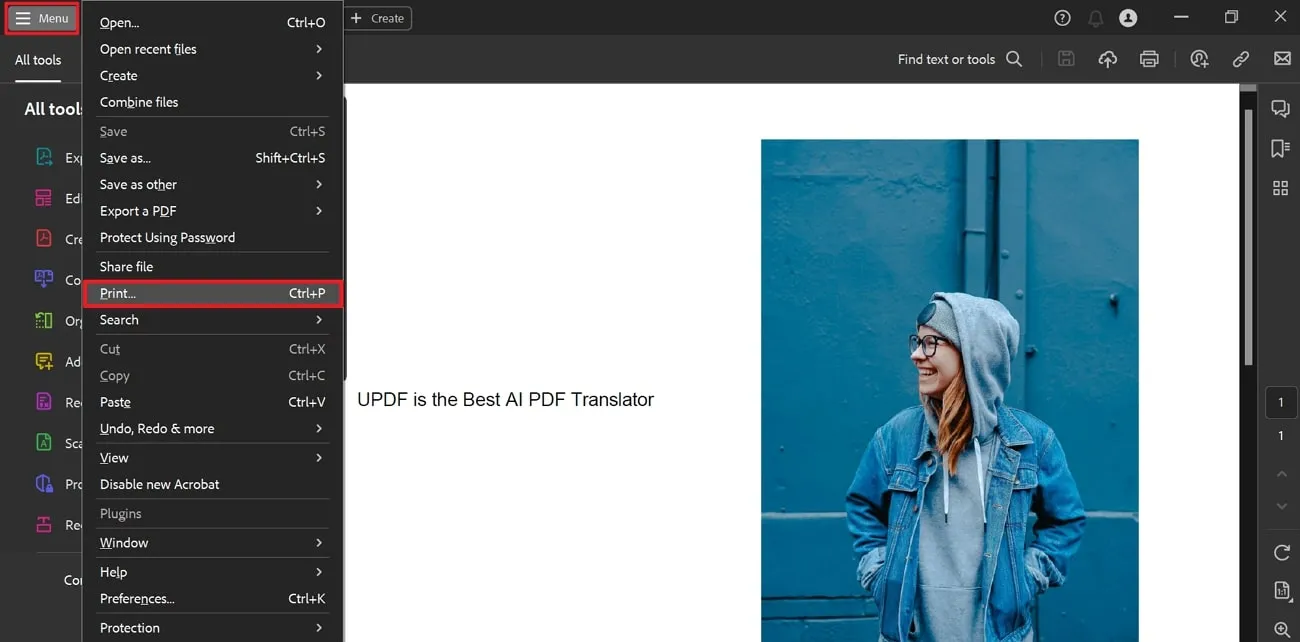
Step 2: After clicking the Print option, you will find a pop-up "Print" window. On this window, you need to click the "Advanced" button to evaluate the value of the DPI of your documents. After this, you will see that your document is set to default 300 DPI, which you can further modify.
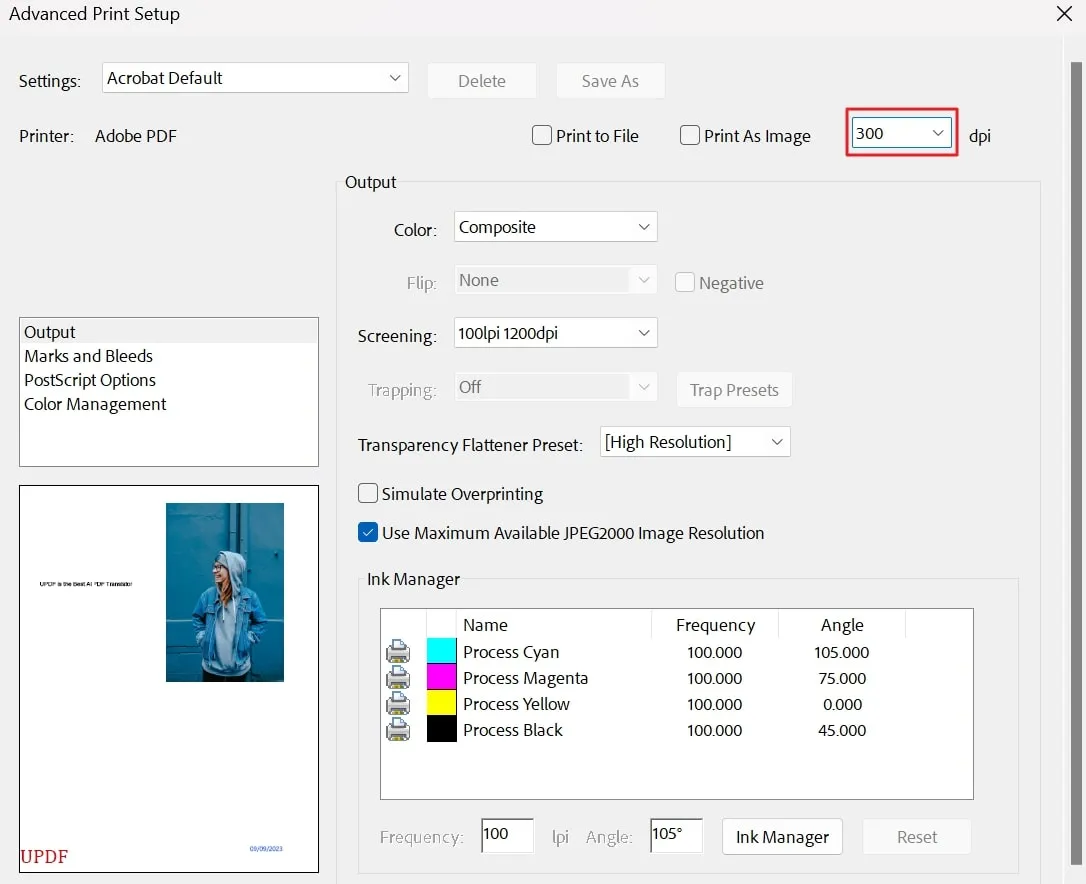
Part 4: How to Increase the DPI of PDF?
After understanding the significance of DPI for documents, we can recognize why there might be a need to increase the DPI in files. In PDFs, a higher DPI means clearer and more detailed images, whether you're printing or viewing on a screen. Let's discuss the procedure using Adobe to increase the DPI of PDFsin the following section:
Step 1: If you want to increase the DPI value, upload your required file first on Adobe. After uploading the file, go to the "Menu" option at the top left side of the main window of the software. This action will give you a vast array of editing options. From here, navigate towards the option of "Print" and click it.
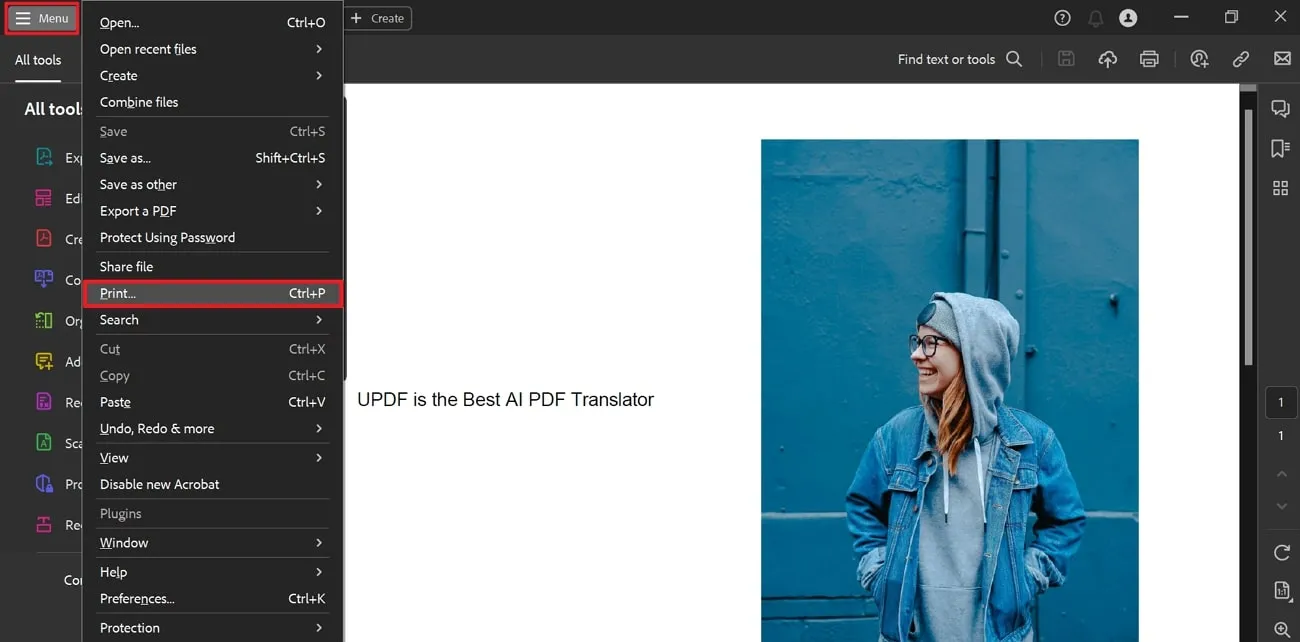
Step 2: Once you have accessed the print capability of the tool, choose the "Advanced" option from the new mini window. Click the "DPI" drop-down menu, where you will find different values to optimize the picture quality. Then, select one of the higher values than your existing document to get a better quality of the pictures in the document.
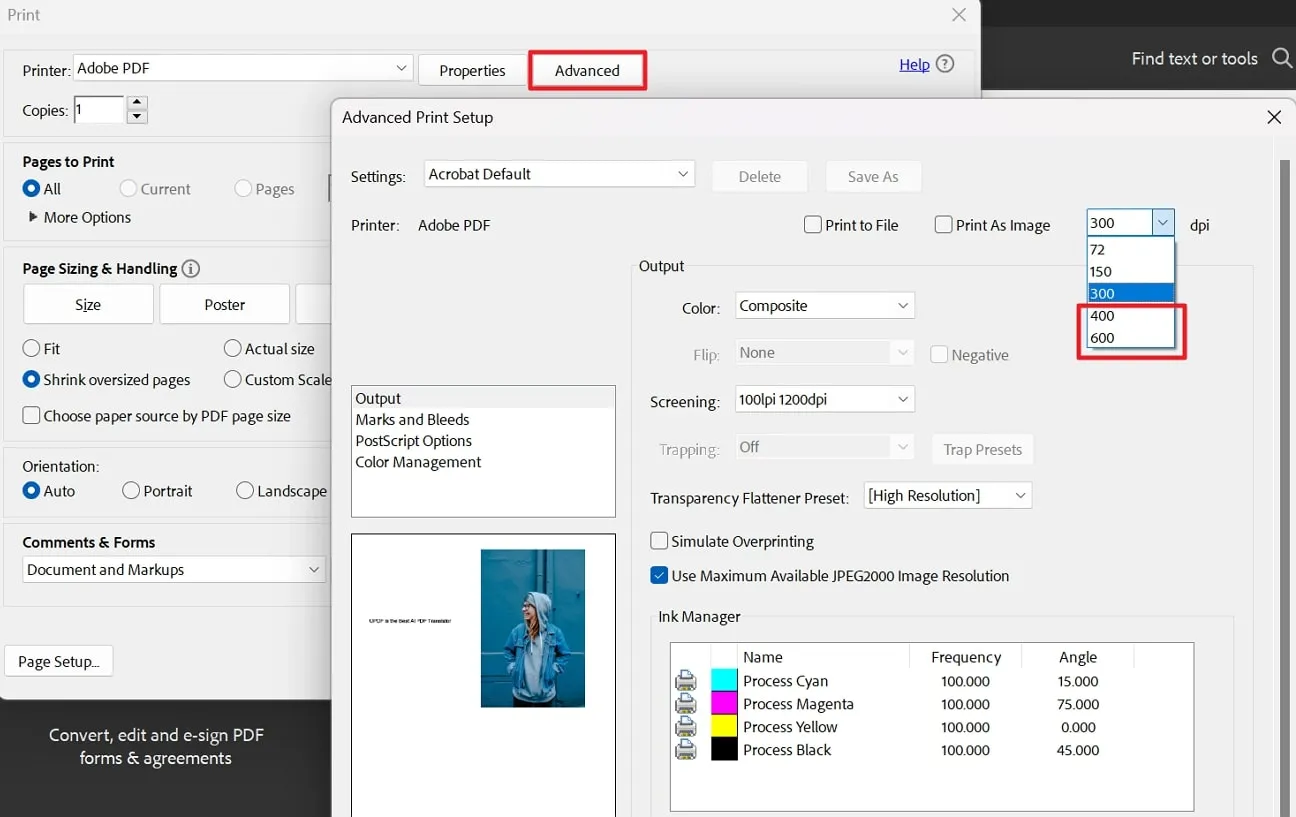
Part 5: How to Lower the DPI of PDF
If we use higher DPI in images, it makes them look better when printed, but it also makes the file sizes larger. You might choose to lower the DPI to make PDFs smaller for sharing online or saving space. Plus, finding the right balance of image quality and compatibility is crucial, depending on how you plan to use the PDF. You will find detailed steps to lower the DPI of PDFs using Adobe in the proceeding section:
Step 1: Once you have uploaded your file in Adobe, press the "Ctrl + P" keys on your keyboard to direct yourself to the "Print" window. Next, select the "Advanced" button after entering the print options within Adobe.
Step 2: Next, navigate to the "DPI" drop-down menu, where various values are listed. Now, lower the value to 200 DPI PDF from a default setting of 300 DPI by entering the value manually. Additionally, you can decrease it from the given values of 150 and 72 DPI to get the required results.
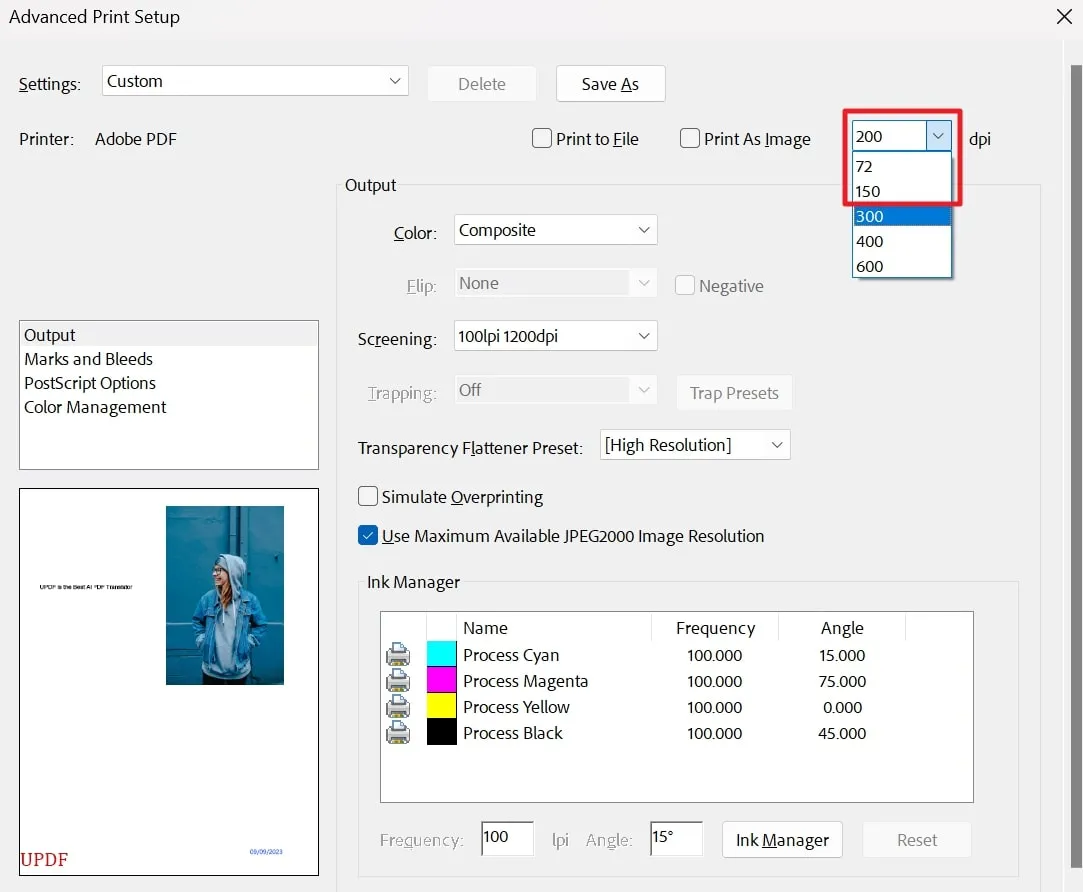
Part 6: The Best PDF Printer You Need to Know
UPDF is the ultimate solution for all your PDF needs and takes the lead as the finest PDF printer. It boasts a range of features designed to elevate your document management experience. With its state-of-the-art capabilities, UPDF ensures smooth operations in printing. Moreover, you can opt for your desired paper size, including letter, tabloid, ledger, A4, A5, and many more.
In addition, users can compress the file size in three different qualities, such as high, medium, and low, for seamless sharing and managing DPI in PDF. The flattening feature of the tool lets you flatten annotations and forms, watermarks, and cropped pages. Further, UPF AI summarizes, translates, and explains complex concepts in your PDFs for its global reach.
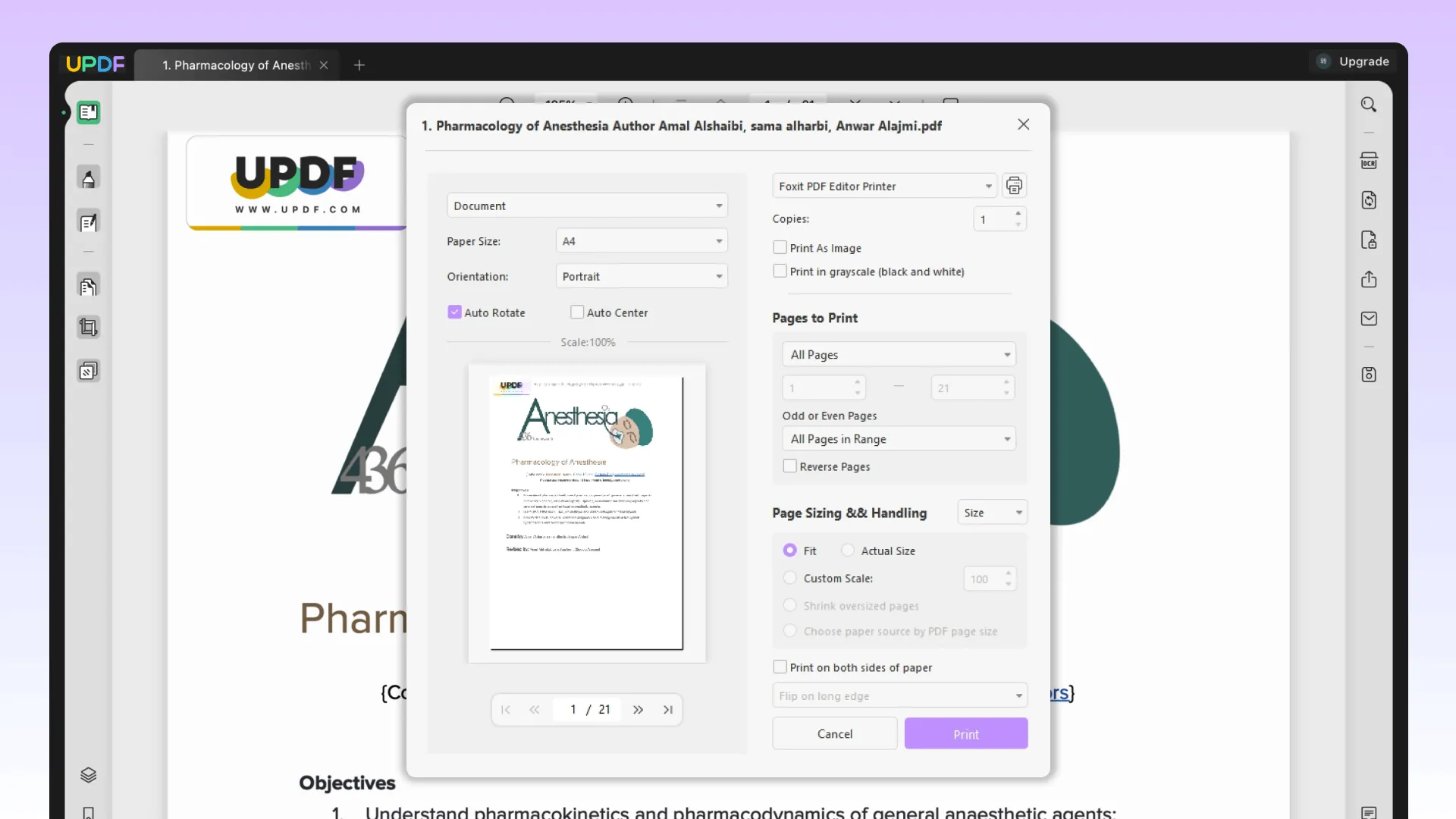
We highly recommend incorporating UPDF into your system for access to an exceptional PDF solution. Simply click on the Download button below to get this exclusive tool.
Windows • macOS • iOS • Android 100% secure
Key Features
- Print PDF: Users can access multiple customization options for the printing process, such as the orientation of the document in portrait or landscape. Moreover, you can handle page sizing, sides, and number of pages.
- Compress File: You have the option to choose the output document quality from the highest to the lowest. In this way, you can compress the file size or boost the sharing process of documents.
- Flatten Documents: If users access the flattening feature of UPDF, they can flatten annotations and forms to prevent other users from editing the information. Plus, it enables you to discard cropped areas of pages while flattening cropped pages.
- AI Features: UPDF's AI provides intelligent suggestions and recommendations for reading PDFs. Furthermore, you can chat with your content, summarize, and translate the text utilizing AI capabilities.
Users can get considerable savings by upgrading to UPDF Pro now. For those looking for a more unbiased evaluation of UPDF, you can visit iDROPNEWS website to read a thorough assessment.
Conclusion
Conclusively, we learned the intricate concept of DPI in PDFs and its significance in our professional lives. It is necessary to modify the print quality, image details, and clarity and to manage files to meet professional standards. In addition, we discussed various methods to check PDF DPI and alter its value using Adobe. Finally, we discovered UPDF to be the best PDF printer one must know and explore its innovative capabilities.
Moreover, users can compress or flatten their files using this tool and can utilize its AI capabilities to streamline the documentation process. We strongly advise integrating UPDF into your system to benefit from an outstanding PDF solution. Just click on the "Free Download" button provided below to access this innovative tool.
Windows • macOS • iOS • Android 100% secure
 UPDF
UPDF
 UPDF for Windows
UPDF for Windows UPDF for Mac
UPDF for Mac UPDF for iPhone/iPad
UPDF for iPhone/iPad UPDF for Android
UPDF for Android UPDF AI Online
UPDF AI Online UPDF Sign
UPDF Sign Read PDF
Read PDF Annotate PDF
Annotate PDF Edit PDF
Edit PDF Convert PDF
Convert PDF Create PDF
Create PDF Compress PDF
Compress PDF Organize PDF
Organize PDF Merge PDF
Merge PDF Split PDF
Split PDF Crop PDF
Crop PDF Delete PDF pages
Delete PDF pages Rotate PDF
Rotate PDF Sign PDF
Sign PDF PDF Form
PDF Form Compare PDFs
Compare PDFs Protect PDF
Protect PDF Print PDF
Print PDF Batch Process
Batch Process OCR
OCR UPDF Cloud
UPDF Cloud About UPDF AI
About UPDF AI UPDF AI Solutions
UPDF AI Solutions FAQ about UPDF AI
FAQ about UPDF AI Summarize PDF
Summarize PDF Translate PDF
Translate PDF Explain PDF
Explain PDF Chat with PDF
Chat with PDF Chat with image
Chat with image PDF to Mind Map
PDF to Mind Map Chat with AI
Chat with AI User Guide
User Guide Tech Spec
Tech Spec Updates
Updates FAQs
FAQs UPDF Tricks
UPDF Tricks Blog
Blog Newsroom
Newsroom UPDF Reviews
UPDF Reviews Download Center
Download Center Contact Us
Contact Us


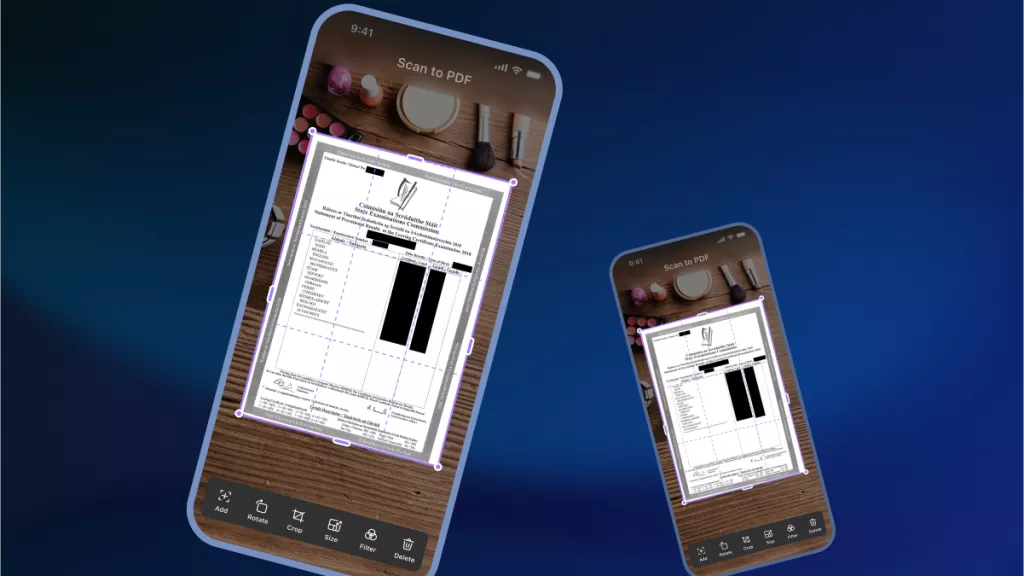

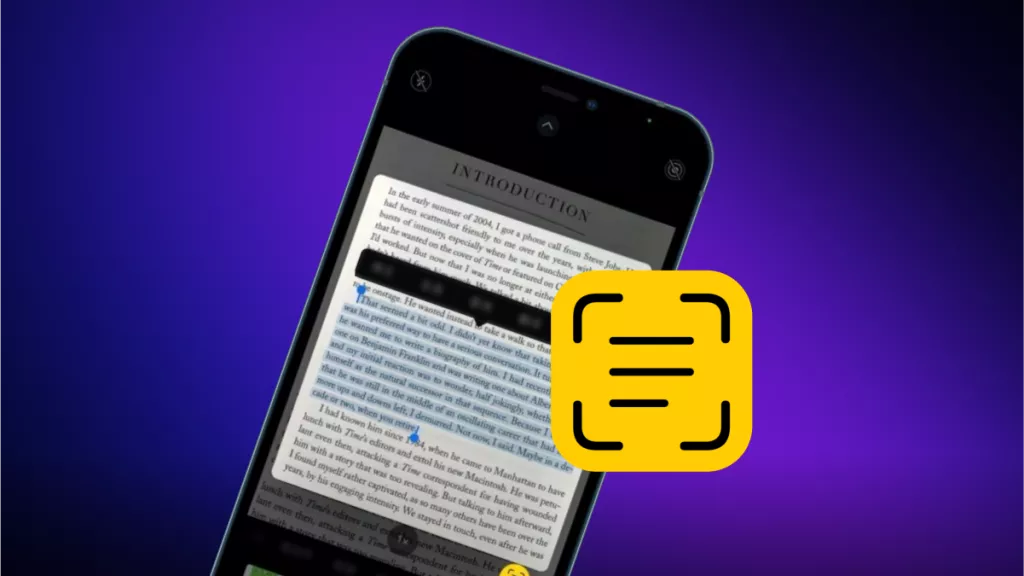

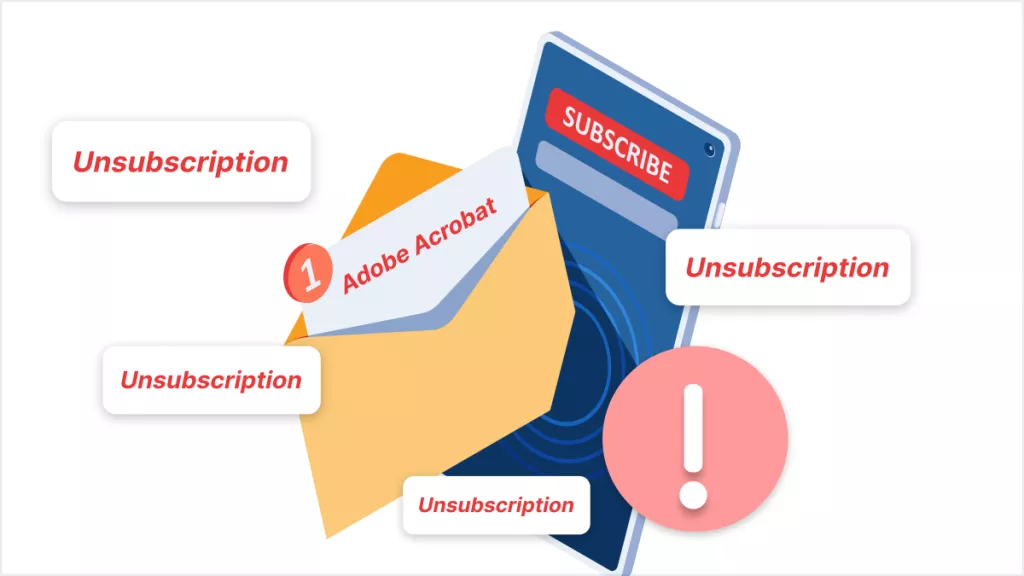

 Lizzy Lozano
Lizzy Lozano 
 Bertha Tate
Bertha Tate 
